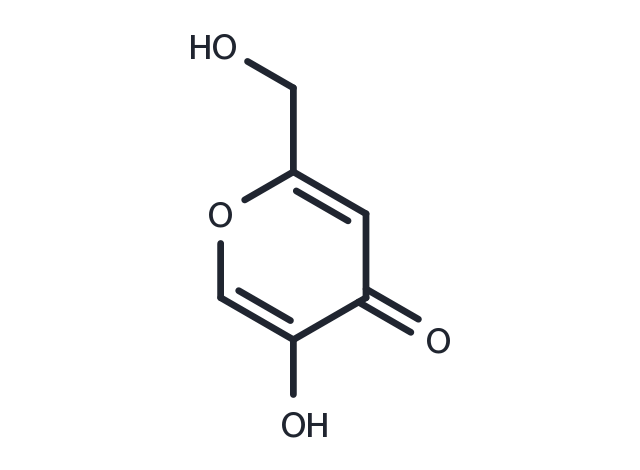Powder: -20°C for 3 years | In solvent: -80°C for 1 year
Kojic acid is a fungal metabolite that inhibits tyrosinase, an enzyme involved in melanin synthesis, with an IC50 value of 30.6 μM for mushroom tyrosinase.

| パッケージサイズ | 在庫状況 | 単価(税別) | |||
|---|---|---|---|---|---|
| サンプルについてお問い合わせ | |||||
| 5 g | 在庫あり | ¥ 9,000 | |||
| 10 g | 在庫あり | ¥ 13,000 | |||
| 1 mL * 10 mM (in DMSO) | 在庫あり | ¥ 10,000 | |||
| 説明 | Kojic acid is a fungal metabolite that inhibits tyrosinase, an enzyme involved in melanin synthesis, with an IC50 value of 30.6 μM for mushroom tyrosinase. |
| In vitro | Kojic acid(KA) (50 μg/mL) was found to decrease the growth by 62% (IC50 34 μg/mL) and 79% (IC50 27.84 μg/mL) of promastigotes and amastigotes in vitro, respectively. KA-treated amastigotes showed the presence of vesicles bodies into the flagellar pocket, and an intense intracellular vacuolization and swelling of the mitochondrion. During the in vitro interaction of parasites and the host cell, KA reverses the superoxide anions (O2-) inhibitory mechanism promoted by parasite[1]. |
| In vivo | 4 weeks after KA-topical formulation treatment of infected animals, a healing process was observed with a high production of collagen fibers and a decrease in parasite burden. The great potential of KA as an anti-leishmanial compound[1]. |
| 細胞研究 | Amazonensis promastigotes (10^6 parasites/mL) were inoculated in a 24-well plate containing RPMI medium supplemented with 10% inactivated fetal bovine serum treated with different concentrations of KA and incubated at 25 °C for 5 days without medium replacement. Every 24 h after treatment, aliquots were harvested and the effect of Kojic acid on promastigotes growth was evaluated using a Neubauer chamber and compared with untreated parasites culture. The cultures were performed in triplicate[1]. |
| 動物実験 | Animals (eight-week-old female Golden hamsters) were infected with 10^6 of L. amazonensis promastigotes/mL during the stationary growth phase with a maximum volume of 0.2 mL on both hind paws.?Animals were separated in 3 groups: untreated (n?=?5);?KA-treated 100 mg/kg/day (n?=?5) and KA vehicle (n?=?5).?KA topical formulation treatment was initiated after 5 weeks of infection.?The KA formulation and vehicle was applied topically to all lesions once daily for 4 weeks.?Control groups were also maintained in parallel.?During the treatment period, the lesion size was measured weekly using a caliper.?Width and height of both hind paws were used to calculate the lesion area (mm^2)[1]. |
| 分子量 | 142.11 |
| 分子式 | C6H6O4 |
| CAS No. | 501-30-4 |
Powder: -20°C for 3 years | In solvent: -80°C for 1 year
DMSO: 55 mg/mL (387.02 mM)
You can also refer to dose conversion for different animals. 詳細
bottom
Please see Inhibitor Handling Instructions for more frequently ask questions. Topics include: how to prepare stock solutions, how to store products, and cautions on cell-based assays & animal experiments, etc.
Kojic acid 501-30-4 Microbiology/Virology Proteases/Proteasome Tyrosinase Parasite inhibit Inhibitor inhibitor
